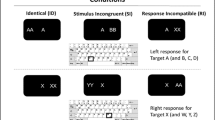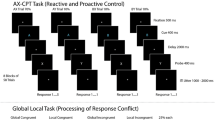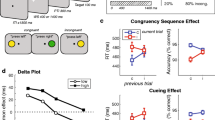Abstract
Goal-directed behavior has been shown to be affected by consciously and subliminally induced conflicts. Both types of conflict conjointly modulate behavioral performance, but the underlying neuronal mechanisms have remained unclear. While cognitive control is linked to oscillations in the theta frequency band, there are several mechanisms via which theta oscillations may enable cognitive control: via the coordination and synchronization of a large and complex neuronal network and/or via local processes within the medial frontal cortex. We, therefore, investigated this issue with a focus on theta oscillations and the underlying neuronal networks. For this purpose, n = 40 healthy young participants performed a conflict paradigm that combines conscious and subliminal distractors while an EEG was recorded. The data show that separate processes modulate the theta-based activation and organization of cognitive control networks: EEG beamforming analyses showed that variations in theta band power generated in the supplementary motor area reflected the need for control and task-relevant goal shielding, as both conflicts as well as their conjoint effect on behavior increased theta power. Yet, large networks were not modulated by this and graph theoretical analyses of the efficiency (i.e. small worldness) of theta-driven networks did not reflect the need for control. Instead, theta network efficiency was decreased by subliminal conflicts only. This dissociation suggests that while both kinds of conflict require control and goal shielding, which are induced by an increase in theta band power and modulate processes in the medial frontal cortex, only non-conscious conflicts diminish the efficiency of theta-driven large-scale networks.




Similar content being viewed by others
References
Achard S, Bullmore E (2007) Efficiency and cost of economical brain functional networks. PLoS Comput Biol 3:e17. https://doi.org/10.1371/journal.pcbi.0030017
Bassett DS, Bullmore E (2006) Small-world brain networks. Neuroscientist 12:512–523. https://doi.org/10.1177/1073858406293182
Battaglia-Mayer A, Babicola L, Satta E (2016) Parieto-frontal gradients and domains underlying eye and hand operations in the action space. Neuroscience 334:76–92. https://doi.org/10.1016/j.neuroscience.2016.07.009
Bauer M, Oostenveld R, Peeters M, Fries P (2006) Tactile spatial attention enhances gamma-band activity in somatosensory cortex and reduces low-frequency activity in parieto-occipital areas. J Neurosci Off J Soc Neurosci 26:490–501. https://doi.org/10.1523/JNEUROSCI.5228-04.2006
Benjamini Y, Hochberg Y (1995) Controlling the false discovery rate: a practical and powerful approach to multiple testing. J R Stat Soc Ser B Methodol 57:289–300
Beste C, Willemssen R, Saft C, Falkenstein M (2010) Response inhibition subprocesses and dopaminergic pathways: basal ganglia disease effects. Neuropsychologia 48:366–373. https://doi.org/10.1016/j.neuropsychologia.2009.09.023
Beste C, Ness V, Lukas C et al (2012) Mechanisms mediating parallel action monitoring in fronto-striatal circuits. NeuroImage 62:137–146. https://doi.org/10.1016/j.neuroimage.2012.05.019
Beste C, Mückschel M, Rosales R et al (2017) The basal ganglia striosomes affect the modulation of conflicts by subliminal information-evidence from X-linked dystonia parkinsonism. Cereb Cortex 1991:1–10. https://doi.org/10.1093/cercor/bhx125
Bielczyk NZ, Walocha F, Ebel PW et al (2018) Thresholding functional connectomes by means of mixture modeling. NeuroImage 171:402–414. https://doi.org/10.1016/j.neuroimage.2018.01.003
Botvinick MM, Braver TS, Barch DM et al (2001) Conflict monitoring and cognitive control. Psychol Rev 108:624–652
Boy F, Husain M, Sumner P (2010) Unconscious inhibition separates two forms of cognitive control. Proc Natl Acad Sci 107:11134–11139. https://doi.org/10.1073/pnas.1001925107
Bullmore E, Sporns O (2009) Complex brain networks: graph theoretical analysis of structural and functional systems. Nat Rev Neurosci 10:186–198. https://doi.org/10.1038/nrn2575
Buzsaki G, Draguhn A (2004) Neuronal oscillations in cortical networks. Science 304:1926–1929. https://doi.org/10.1126/science.1099745
Cavanagh JF, Frank MJ (2014) Frontal theta as a mechanism for cognitive control. Trends Cogn Sci 18:414–421. https://doi.org/10.1016/j.tics.2014.04.012
Cavanagh JF, Zambrano-Vazquez L, Allen JJB (2012) Theta lingua franca: a common mid-frontal substrate for action monitoring processes. Psychophysiology 49:220–238. https://doi.org/10.1111/j.1469-8986.2011.01293.x
Chmielewski WX, Mückschel M, Dippel G, Beste C (2016) Concurrent information affects response inhibition processes via the modulation of theta oscillations in cognitive control networks. Brain Struct Funct 221:3949–3961. https://doi.org/10.1007/s00429-015-1137-1
Cohen MX (2014) A neural microcircuit for cognitive conflict detection and signaling. Trends Neurosci 37:480–490. https://doi.org/10.1016/j.tins.2014.06.004
Cohen MX, Donner TH (2013) Midfrontal conflict-related theta-band power reflects neural oscillations that predict behavior. J Neurophysiol 110:2752–2763. https://doi.org/10.1152/jn.00479.2013
Colebatch JG (2007) Bereitschaftspotential and movement-related potentials: origin, significance, and application in disorders of human movement. Mov Disord 22:601–610. https://doi.org/10.1002/mds.21323
De Blasio FM, Barry RJ (2013) Prestimulus delta and theta determinants of ERP responses in the Go/NoGo task. Int J Psychophysiol Off J Int Organ Psychophysiol 87:279–288. https://doi.org/10.1016/j.ijpsycho.2012.09.016
Deecke L, Kornhuber HH (1978) An electrical sign of participation of the mesial ‘supplementary’ motor cortex in human voluntary finger movement. Brain Res 159:473–476. https://doi.org/10.1016/0006-8993(78)90561-9
Diamond A (2013) Executive functions. Annu Rev Psychol 64:135–168. https://doi.org/10.1146/annurev-psych-113011-143750
Eimer M, Schlaghecken F (2003) Response facilitation and inhibition in subliminal priming. Biol Psychol 64:7–26. https://doi.org/10.1016/S0301-0511(03)00100-5
Evans AC, Collins DL, Milner B, Milner B (1992) An MRI-based stereotactic atlas from 250 young normal subjects. Soc Neurosci Abstr 18:408
Fassbender C, Hester R, Murphy K et al (2009) Prefrontal and midline interactions mediating behavioural control. Eur J Neurosci 29:181–187. https://doi.org/10.1111/j.1460-9568.2008.06557.x
Gohil K, Bluschke A, Roessner V et al (2017) ADHD patients fail to maintain task goals in face of subliminally and consciously induced cognitive conflicts. Psychol Med 47:1771–1783. https://doi.org/10.1017/s0033291717000216
Goschke T, Bolte A (2014) Emotional modulation of control dilemmas: the role of positive affect, reward, and dopamine in cognitive stability and flexibility. Neuropsychologia 62:403–423. https://doi.org/10.1016/j.neuropsychologia.2014.07.015
Goschke T, Dreisbach G (2008) Conflict-triggered goal shielding: response conflicts attenuate background monitoring for prospective memory cues. Psychol Sci 19:25–32. https://doi.org/10.1111/j.1467-9280.2008.02042.x
Gross J, Kujala J, Hamalainen M et al (2001) Dynamic imaging of coherent sources: studying neural interactions in the human brain. Proc Natl Acad Sci 98:694–699. https://doi.org/10.1073/pnas.98.2.694
Halsband U, Matsuzaka Y, Tanji J (1994) Neuronal activity in the primate supplementary, pre-supplementary and premotor cortex during externally and internally instructed sequential movements. Neurosci Res 20:149–155. https://doi.org/10.1016/0168-0102(94)90032-9
Hampshire A, Sharp DJ (2015) Contrasting network and modular perspectives on inhibitory control. Trends Cogn Sci 19:445–452. https://doi.org/10.1016/j.tics.2015.06.006
Harper J, Malone SM, Bernat EM (2014) Theta and delta band activity explain N2 and P3 ERP component activity in a go/no-go task. Clin Neurophysiol Off J Int Fed Clin Neurophysiol 125:124–132. https://doi.org/10.1016/j.clinph.2013.06.025
Hoogenboom N, Schoffelen J-M, Oostenveld R et al (2006) Localizing human visual gamma-band activity in frequency, time and space. NeuroImage 29:764–773. https://doi.org/10.1016/j.neuroimage.2005.08.043
Jin S-H, Lin P, Hallett M (2012) Reorganization of brain functional small-world networks during finger movements. Hum Brain Mapp 33:861–872. https://doi.org/10.1002/hbm.21253
Keller I, Heckhausen H (1990) Readiness potentials preceding spontaneous motor acts: voluntary vs. involuntary control. Electroencephalogr Clin Neurophysiol 76:351–361
Keye D, Wilhelm O, Oberauer K, Stürmer B (2013) Individual differences in response conflict adaptations. Front Psychol 4:947. https://doi.org/10.3389/fpsyg.2013.00947
Langer N, von Bastian CC, Wirz H et al (2013) The effects of working memory training on functional brain network efficiency. Cortex 49:2424–2438. https://doi.org/10.1016/j.cortex.2013.01.008
Li Y, Chen Y, Lv X et al (2015) EEG functional network properties related to visually induced unrecognized spatial disorientation. Biomed Mater Eng 26:S1115–S1124. https://doi.org/10.3233/BME-151408
Maris E, Oostenveld R (2007) Nonparametric statistical testing of EEG- and MEG-data. J Neurosci Methods 164:177–190. https://doi.org/10.1016/j.jneumeth.2007.03.024
Masson MEJ (2011) A tutorial on a practical Bayesian alternative to null-hypothesis significance testing. Behav Res Methods 43:679–690. https://doi.org/10.3758/s13428-010-0049-5
Matsuzaka Y, Aizawa H, Tanji J (1992) A motor area rostral to the supplementary motor area (presupplementary motor area) in the monkey: neuronal activity during a learned motor task. J Neurophysiol 68:653–662
McBride J, Boy F, Husain M, Sumner P (2012) Automatic motor activation in the executive control of action. Front Hum Neurosci 6:82. https://doi.org/10.3389/fnhum.2012.00082
Miller EK, Cohen JD (2001) An integrative theory of prefrontal cortex function. Annu Rev Neurosci 24:167–202. https://doi.org/10.1146/annurev.neuro.24.1.167
Mückschel M, Stock A-K, Dippel G et al (2016) Interacting sources of interference during sensorimotor integration processes. NeuroImage 125:342–349. https://doi.org/10.1016/j.neuroimage.2015.09.075
Nolte G, Bai O, Wheaton L et al (2004) Identifying true brain interaction from EEG data using the imaginary part of coherency. Clin Neurophysiol 115:2292–2307. https://doi.org/10.1016/j.clinph.2004.04.029
Nunez PL, Pilgreen KL (1991) The spline-Laplacian in clinical neurophysiology: a method to improve EEG spatial resolution. J Clin Neurophysiol Off Publ Am Electroencephalogr Soc 8:397–413
O’Connell RG, Dockree PM, Bellgrove MA et al (2007) The role of cingulate cortex in the detection of errors with and without awareness: a high-density electrical mapping study: error awareness. Eur J Neurosci 25:2571–2579. https://doi.org/10.1111/j.1460-9568.2007.05477.x
Oostenveld R, Stegeman DF, Praamstra P, van Oosterom A (2003) Brain symmetry and topographic analysis of lateralized event-related potentials. Clin Neurophysiol Off J Int Fed Clin Neurophysiol 114:1194–1202
Oostenveld R, Fries P, Maris E, Schoffelen J-M (2011) FieldTrip: open source software for advanced analysis of MEG, EEG, and invasive electrophysiological data. Comput Intell Neurosci 2011:156869. https://doi.org/10.1155/2011/156869
Parkinson J, Haggard P (2014) Subliminal priming of intentional inhibition. Cognition 130:255–265. https://doi.org/10.1016/j.cognition.2013.11.005
Perrin F, Pernier J, Bertrand O, Echallier JF (1989) Spherical splines for scalp potential and current density mapping. Electroencephalogr Clin Neurophysiol 72:184–187
Picard N (2003) Activation of the supplementary motor area (SMA) during performance of visually guided movements. Cereb Cortex 13:977–986. https://doi.org/10.1093/cercor/13.9.977
Roland PE, Larsen B, Lassen NA, Skinhøj E (1980a) Supplementary motor area and other cortical areas in organization of voluntary movements in man. J Neurophysiol 43:118–136
Roland PE, Skinhøj E, Lassen NA, Larsen B (1980b) Different cortical areas in man in organization of voluntary movements in extrapersonal space. J Neurophysiol 43:137–150
Rubinov M, Sporns O (2010) Complex network measures of brain connectivity: uses and interpretations. NeuroImage 52:1059–1069. https://doi.org/10.1016/j.neuroimage.2009.10.003
Salvador R, Suckling J, Coleman MR et al (2005) Neurophysiological architecture of functional magnetic resonance images of human brain. Cereb Cortex 15:1332–1342. https://doi.org/10.1093/cercor/bhi016
Schiffer A-M, Waszak F, Yeung N (2015) The role of prediction and outcomes in adaptive cognitive control. J Physiol-Paris 109:38–52. https://doi.org/10.1016/j.jphysparis.2015.02.001
Schlaghecken F, Eimer M (2004) Masked prime stimuli can bias “free” choices between response alternatives. Psychon Bull Rev 11:463–468. https://doi.org/10.3758/BF03196596
Schneider TR, Debener S, Oostenveld R, Engel AK (2008) Enhanced EEG gamma-band activity reflects multisensory semantic matching in visual-to-auditory object priming. NeuroImage 42:1244–1254. https://doi.org/10.1016/j.neuroimage.2008.05.033
Sporns O, Chialvo D, Kaiser M, Hilgetag C (2004) Organization, development and function of complex brain networks. Trends Cogn Sci 8:418–425. https://doi.org/10.1016/j.tics.2004.07.008
Sporns O, Tononi G, Kötter R (2005) The human connectome: a structural description of the human brain. PLoS Comput Biol 1:e42. https://doi.org/10.1371/journal.pcbi.0010042
Stock A-K, Friedrich J, Beste C (2016) Subliminally and consciously induced cognitive conflicts interact at several processing levels. Cortex J Devoted Study Nerv Syst Behav 85:75–89. https://doi.org/10.1016/j.cortex.2016.09.027
Tallon-Baudry C, Bertrand O, Delpuech C, Permier J (1997) Oscillatory gamma-band (30–70 Hz) activity induced by a visual search task in humans. J Neurosci Off J Soc Neurosci 17:722–734
Telesford QK, Joyce KE, Hayasaka S et al (2011) The ubiquity of small-world networks. Brain Connect 1:367–375. https://doi.org/10.1089/brain.2011.0038
Ulrich R, Schröter H, Leuthold H, Birngruber T (2015) Automatic and controlled stimulus processing in conflict tasks: superimposed diffusion processes and delta functions. Cogn Psychol 78:148–174. https://doi.org/10.1016/j.cogpsych.2015.02.005
Wagenmakers E (2007) A practical solution to the pervasive problems of p values. Psychon Bull Rev 14:779–804
Watts DJ, Strogatz SH (1998) Collective dynamics of ‘small-world’ networks. Nature 393:440–442. https://doi.org/10.1038/30918
Womelsdorf T, Vinck M, Leung LS, Everling S (2010) Selective theta-synchronization of choice-relevant information subserves goal-directed behavior. Front Hum Neurosci 4:210. https://doi.org/10.3389/fnhum.2010.00210
Yordanova J, Falkenstein M, Hohnsbein J, Kolev V (2004) Parallel systems of error processing in the brain. NeuroImage 22:590–602. https://doi.org/10.1016/j.neuroimage.2004.01.040
Yu S, Huang D, Singer W, Nikolić D (2008) A small world of neuronal synchrony. Cereb Cortex 18:2891–2901. https://doi.org/10.1093/cercor/bhn047
Funding
This study was funded by a grant of the Deutsche Forschungsgemeinschaft (DFG) SFB940 B8 to A.S. and C.B.
Author information
Authors and Affiliations
Corresponding author
Ethics declarations
Conflict of interest
The authors declare that they have no conflict of interest.
Informed consent
Each participant gave a written informed consent and was reimbursed with either 25€ or course credits for taking part in the study. The study was approved by the ethics committee of the Faculty of Medicine of TU Dresden and conducted in accordance with the Declaration of Helsinki.
Additional information
Publisher's Note
Springer Nature remains neutral with regard to jurisdictional claims in published maps and institutional affiliations.
Electronic supplementary material
Below is the link to the electronic supplementary material.
Rights and permissions
About this article
Cite this article
Bensmann, W., Zink, N., Mückschel, M. et al. Neuronal networks underlying the conjoint modulation of response selection by subliminal and consciously induced cognitive conflicts. Brain Struct Funct 224, 1697–1709 (2019). https://doi.org/10.1007/s00429-019-01866-0
Received:
Accepted:
Published:
Issue Date:
DOI: https://doi.org/10.1007/s00429-019-01866-0




